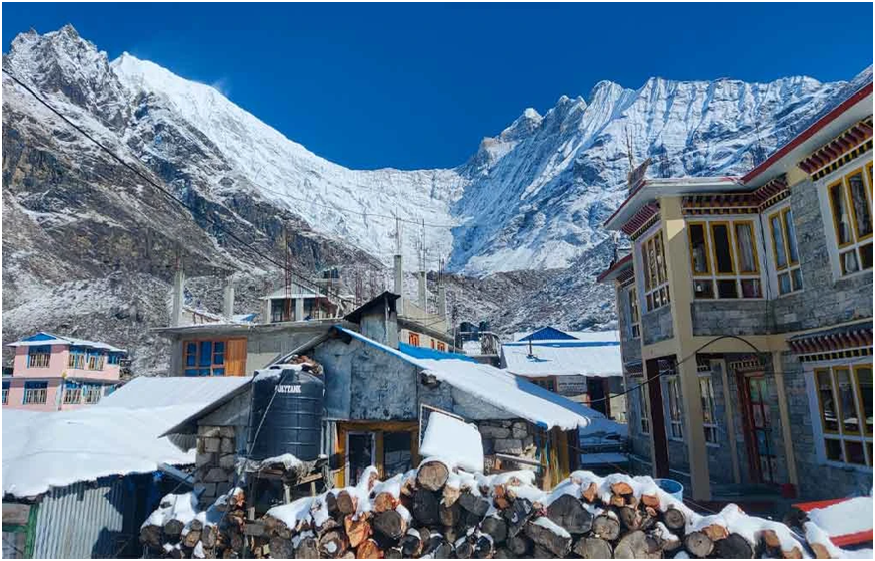The Everest region of Nepal is home to some of the most awe-inspiring landscapes on Earth, drawing trekkers from around the world to its towering peaks, vibrant Sherpa culture, and high-altitude adventures. From the classic Everest Base Camp Trek to the exhilarating Three Pass Trek, and convenient options like the Everest Base Camp Trek with Return Helicopter, each journey offers a unique and unforgettable experience. In this article, we explore four of the most popular treks in the Everest region to help you choose your perfect Himalayan adventure.
1. Everest Base Camp Trek –
Overview
The Everest Base Camp Trek is an amazing course that takes you to the base of the world’s most noteworthy peak—Mount Everest (8,848.86 meters). Traversing approximately 12–14 days, this journey is an immersive enterprise into the heart of the Khumbu locale, filled with breathtaking sights, old cloisters, and dynamic Sherpa towns.
Highlights
- Reach Everest Base Camp at 5,364 meters
- Hike to Kala Patthar (5,545 m) for panoramic views of Everest
- Explore Namche Bazaar, Tengboche Monastery, and Khumbu Glacier
- Cross suspension bridges over deep gorges and icy rivers
- Learn about Sherpa traditions, Buddhism, and mountain life
Trekking Experience
Starting with a scenic flight from Kathmandu to Lukla, the journey begins with a walk through pine forests and villages like Phakding and Namche Bazaar—the gateway to Everest. The altitude gradually increases as you pass Tengboche and Dingboche before reaching Everest Base Camp. The final push to Kala Patthar offers the best views of Everest and surrounding giants like Nuptse and Lhotse.
Best Time to Trek
The best seasons are spring (March–May) and autumn (September–November), offering clear skies, moderate temperatures, and vibrant trails.
2. Everest Base Camp Trek with Return by Helicopter – Trek In, Fly Out
Overview
For those seeking the thrill of trekking to Everest Base Camp without retracing their steps, the Everest Base Camp Trek with Helicopter Return offers the idealized adjustment of experience and consolation. After trekking to base camp, you return to Kathmandu through a marvelous helicopter ride, sparing time and lessening physical strain.
Highlights
- Same trekking route as the classic EBC Trek up to base camp
- Helicopter return offers unmatched aerial views of the Himalayas
- Ideal for trekkers with limited time or physical limitations
- Includes views of Ama Dablam, Everest, Pumori, and the Khumbu Icefall from above
- Luxury add-on for a memorable finish to your journey
Experience
You follow the same itinerary as the standard EBC trek:Lukla, Namche, Tengboche, and Gorak Shep. After reaching base camp and hiking Kala Patthar, you board a helicopter for a jaw-dropping flight over the Khumbu Glacier, mountain passes, and deep valleys—an unforgettable highlight of the trek.
Who Should Choose This?
- Time-conscious trekkers wanting to cut 3–4 days from the descent
- Luxury seekers looking for a high-end experience
- Trekkers recovering from altitude fatigue or injury
3. Three Pass Trek – The Ultimate Everest Challenge
Overview
The Three Pass Trek is the most comprehensive and requesting journey in the Everest locale. It combines the standard Everest Base Camp path with intersections of three tall mountain passes: Kongma La (5,535 m), Cho La (5,420 m), and Renjo La (5,360 m). It’s the extreme challenge for prepared trekkers needing full inundation in the Himalayas.
Highlights
- Cross three spectacular high-altitude passes
- Visit Everest Base Camp and Kala Patthar
- Explore remote valleys like Gokyo and Chukhung
- Stunning views of Everest, Makalu, Cho Oyu, and Lhotse
- Less-crowded trails with off-the-beaten-path experience
Itinerary Snapshot
The trek starts at Lukla, then follows the standard route to Chukhung before the first pass: Kongma La. After going to Everest Base Camp and Kala Patthar, trekkers handle Cho La Pass to reach Gokyo Valley, domestic to peaceful turquoise lakes. The last challenge is Renjo La Pass, which leads to Thame some time recently circling back to Namche Bazaar and Lukla.
Difficulty and Preparation
This trek is challenging due to its altitude, steep ascents, and exposure to unpredictable weather. Proper acclimatization, physical fitness, and prior trekking experience are recommended.
Who Should Trek It?
- Experienced trekkers looking for a true Himalayan test
- Photographers and nature lovers wanting diverse landscapes
- Adventurers seeking solitude and variety in the Everest region
4. Everest Base Camp Trek – 12 Days:
Overview
Pressed for time but still want the full Everest Base Camp experience? The Everest Base Camp Trek – 12 Days itinerary is a compressed version of the classic trek, ideal for trekkers in good shape and looking for an efficient way to complete the journey.
Highlights
- Complete the trek in just 12 days round-trip from Kathmandu
- Streamlined acclimatization days to maintain safety
- Reach base camp and Kala Patthar within a tight schedule
- Fewer rest days, faster pace
- Ideal for physically fit travelers
Trek Flow
The trek typically begins with a flight to Lukla, then continues to Namche Bazaar, with one acclimatization day before progressing to Tengboche, Dingboche, and Lobuche. On Day 9 or 10, trekkers reach Everest Base Camp and Kala Patthar. The descent is quick, concluding the trek in 12 days.
Suitability
- Best for fit trekkers with limited vacation days
- Suitable for those who can handle quicker elevation gain
- Not ideal for first-time high-altitude trekkers
Acclimatization Consideration
Although faster, the itinerary still includes at least one acclimatization day to help the body adjust. However, symptoms of altitude sickness should be monitored carefully.
Comparison Table: Everest Region Treks
| Feature | EBC Classic | EBC + Helicopter | Three Pass Trek | EBC – 12 Days |
| Duration | 12–14 days | 11–12 days | 18–21 days | 12 days |
| Maximum Altitude | 5,545 m | 5,545 m | 5,545 m + 3 passes | 5,545 m |
| Difficulty | Moderate | Moderate | Challenging | Moderate+ |
| Best For | General trekkers | Time-limited trekkers | Experienced adventurers | Fit trekkers |
| Key Highlight | Everest Base Camp | Helicopter return | Three mountain passes | Fast-paced adventure |
| Acclimatization Days | 2 | 2 | 3+ | 1 |
Culture, People & Wildlife
The Khumbu region is wealthy in Sherpa culture, and each journey offers the opportunity to visit conventional towns, associated with neighborhood individuals, and visit antiquated cloisters like Tengboche. Supplication banners, mani stones, and chortens line the trails, advertising otherworldly reverberation to the physical challenge.
You might spot Himalayan tahr, musk deer, and colorful birds, particularly in the Sagarmatha National park.
Tips for a Safe and Enjoyable Everest Region Trek
- Acclimatize properly – Never rush altitude gain; use rest days.
- Train before trekking – Cardio, strength, and hiking preparation are essential.
- Stay hydrated – Dehydration increases the risk of altitude sickness.
- Travel with a guide or group – Local experts can provide safety and cultural insights.
- Pack smart – Include layers, a good sleeping bag, down jacket, sun protection, and first-aid essentials.
- Consider insurance – High-altitude trekking insurance that covers helicopter evacuation is a must.
Conclusion – Choose Your Everest Adventure
Whether you’re a first-time trekker looking to walk in the footsteps of legends, or a seasoned adventurer craving the challenge of high passes and remote valleys, the Everest region has a trek tailored for you. The classic Everest Base Camp Trek is a rite of passage for many. If you’re short on time or energy for the return journey, the helicopter return version offers luxury and convenience. For those who seek solitude and tougher terrain, the Three Pass Trek is the ultimate challenge. And if you’re fit and pressed for time, the 12-day itinerary ensures you don’t miss out on the world’s most iconic trail.
No matter which option you choose, trekking in the shadow of Everest is a once-in-a-lifetime experience that will inspire, humble, and stay with you forever.
Frequently Asked Questions
Q1: How difficult is the Everest Base Camp Trek?
The classic EBC trek is moderate. While challenging due to altitude, it’s achievable for anyone with decent fitness and preparation.
Q2: Is a guide mandatory for the Everest region?
Yes. As of 2023, solo trekking is no longer permitted in most parts of Nepal, including the Everest region. A licensed guide is mandatory.
Q3: How cold does it get on the trail?
Temperatures can drop to -10°C to -20°C at night at higher elevations like Gorak Shep and Kala Patthar, especially in early spring and late autumn.
Q4: Do I need permits for the trek?
Yes. You’ll need:
- Sagarmatha National Park Entry Permit
- Khumbu Pasang Lhamu Rural Municipality Permit
Q5: What’s the helicopter return cost from Everest Base Camp?
Prices vary by season and group size, but expect to pay between $900–$1200 per person for a group-sharing flight.
Q6: What is the best month to trek Everest?
October and November offer stable weather and clear skies. April and May are also great with blooming rhododendrons and milder weather.
Booking Process by Adventure Great Himalaya Treks:
To book any of these treks tours through Adventure Great Himalaya A Best Trekking Company In nepal ,To discuss your preferred dates, group size, and specific needs. They will provide a detailed itinerary covering these trek’s duration, highlights, cost, and inclusions such as a guide, porter, meals, accommodation, and transportation.
Prior to the trek, you will receive a comprehensive pre-trek briefing with essential information on packing, fitness preparation, and altitude acclimatization. The agency will finalize all logistical arrangements, including transportation, accommodation, and permits, to ensure everything is in place for your trek. Upon arrival in Nepal, the team will ensure that all aspects of the trek are organized, providing you with a smooth and unforgettable experience on these treks.




